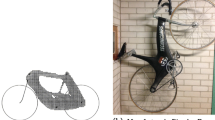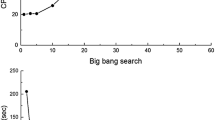Abstract
Evolutionary Structural Optimization (ESO) and its later version bi-directional ESO (BESO) have gained widespread popularity among researchers in structural optimization and practitioners in engineering and architecture. However, there have also been many critical comments on various aspects of ESO/BESO. To address those criticisms, we have carried out extensive work to improve the original ESO/BESO algorithms in recent years. This paper summarizes latest developments in BESO for stiffness optimization problems and compares BESO with other well-established optimization methods. Through a series of numerical examples, this paper provides answers to those critical comments and shows the validity and effectiveness of the evolutionary structural optimization method.






Similar content being viewed by others
References
Bendsøe MP (1989) Optimal shape design as a material distribution problem. Struct Optim 1:193–202
Bendsøe MP, Sigmund O (2003) Topology optimization: theory, methods and applications. Springer, Heidelberg
Chu DN, Xie YM, Hira A, Steven GP (1996) Evolutionary structural optimization for problems with stiffness constraints. Finite Elem Anal Des 21:239–251
Cui C, Ohmori H, Sasaki M (2005) Structural design by extended ESO method. In: Proceedings of frontiers of computational sciences symposium, Nagoya, Japan, 11–13 October 2005, pp 149–156
Edwards CS, Kim HA, Budd CJ (2007) An evaluative study on ESO and SIMP for optimizing a cantilever tie-beam. Struct Multidisc Optim 34(5):403–414
Huang X, Xie YM (2007) Convergent and mesh-independent solutions for the bi-directional evolutionary structural optimization method. Finite Elem Anal Des 43:1039–1049
Huang X, Xie YM (2008) A new look at the ESO/BESO optimization methods. Struct Multidisc Optim 35(1):89–92
Huang X, Xie YM (2009a) Bi-directional evolutionary topology optimization of continuum structures with one or multiple materials. Comput Mech 43(3):393–401. doi:10.1007/s00466-008-0312-0
Huang X, Xie YM (2009b) Evolutionary topology optimization of continuum structures with a local displacement constraint. Struct Multidisc Optim 40:409–416. doi:10.1007/s00158-009-0382-4
Norato JA, Bendsøe MP, Harber RB, Tortorelli DA (2007) A topological derivative method for topology optimization. Struct Multidisc Optim 33:375–386
Ohmori H, Futai H, Iijima T, Muto A, Hasegawa Y (2005) Application of computational morphogenesis to structural design. In: Proceedings of frontiers of computational sciences symposium, Nagoya, Japan, 11–13 October 2005, pp 45–52
Querin OM, Steven GP, Xie YM (1998) Evolutionary structural optimization (ESO) using a bi-directional algorithm. Eng Comput 15:1031–1048
Querin OM, Young V, Steven GP, Xie YM (2000) Computational efficiency and validation of bi-directional evolutionary structural optimization. Comput Methods Appl Mech Eng 189:559–573
Rozvany GIN (2009) A critical review of established methods of structural topology optimization. Struct Multidisc Optim 37:217–237
Rozvany GIN, Querin OM (2002) Combining ESO with rigorous optimality criteria. Int J Veh Des 28:294–299
Rozvany GIN, Zhou M, Sigmund O (1994) Optimization of topology. In: Adeli H (ed) Advances in design optimization. Chapman & Hall, London
Sigmund O (1997) On the design of compliant mechanisms using topology optimization. Mech Struct Mach 25:495–592
Sigmund O (2001) A 99 line topology optimization code written in Matlab. Struct Multidisc Optim 21:120–127
Sigmund O, Petersson J (1998) Numerical instability in topology optimization: a survey on procedures dealing with checkerboards, mesh-dependencies and local minima. Struct Optim 16:68–75
Stolpe M, Svanberg K (2001) On the trajectories of penalization methods for topology optimization. Struct Multidisc Optim 21:128–139
Xie YM, Steven GP (1992) Shape and layout optimization via an evolutionary procedure. In: Proceedings of the international conference computational engineering science. Hong Kong, p 421
Xie YM, Steven GP (1993) A simple evolutionary procedure for structural optimization. Comput Struct 49:885–896
Xie YM, Steven GP (1997) Evolutionary structural optimization. Springer, London
Yang XY, Xie YM, Steven GP, Querin OM (1999) Bidirectional evolutionary method for stiffness optimization. AIAA J 37(11):1483–1488
Zhou M, Rozvany GIN (1991) The COC algorithm, part II: topological, geometry and generalized shape optimization. Comput Methods Appl Mech Eng 89:197–224
Zhou M, Rozvany GIN (2001) On the validity of ESO type methods in topology optimization. Struct Multidisc Optim 21:80–83
Acknowledgments
The authors wish to acknowledge the financial support from the Australian Research Council for carrying out this work.
Author information
Authors and Affiliations
Corresponding author
Appendix
Appendix
This appendix contains a soft-kill BESO Matlab code that can be used to solve simple 2D stiffness optimization problems. The code is developed based on the 99 line SIMP code (Sigmund 2001). The design domain is assumed to be rectangular and discretized using four node plane stress elements. Here, a cantilever is taken as an example. Other structures with different loading and boundary conditions can be solved by modifying lines 80–84 of the code. The input data are:
- nelx :
-
total number of elements in the horizontal direction.
- nely :
-
total number of elements in the vertical direction.
- volfrac :
-
volume fraction which defines the ratio of the final volume and the design domain volume.
- er :
-
evolutionary rate, normally 0.02.
- rmin :
-
filter radius, normally 3 (or the size of several elements).


Rights and permissions
About this article
Cite this article
Huang, X., Xie, YM. A further review of ESO type methods for topology optimization. Struct Multidisc Optim 41, 671–683 (2010). https://doi.org/10.1007/s00158-010-0487-9
Received:
Revised:
Accepted:
Published:
Issue Date:
DOI: https://doi.org/10.1007/s00158-010-0487-9




